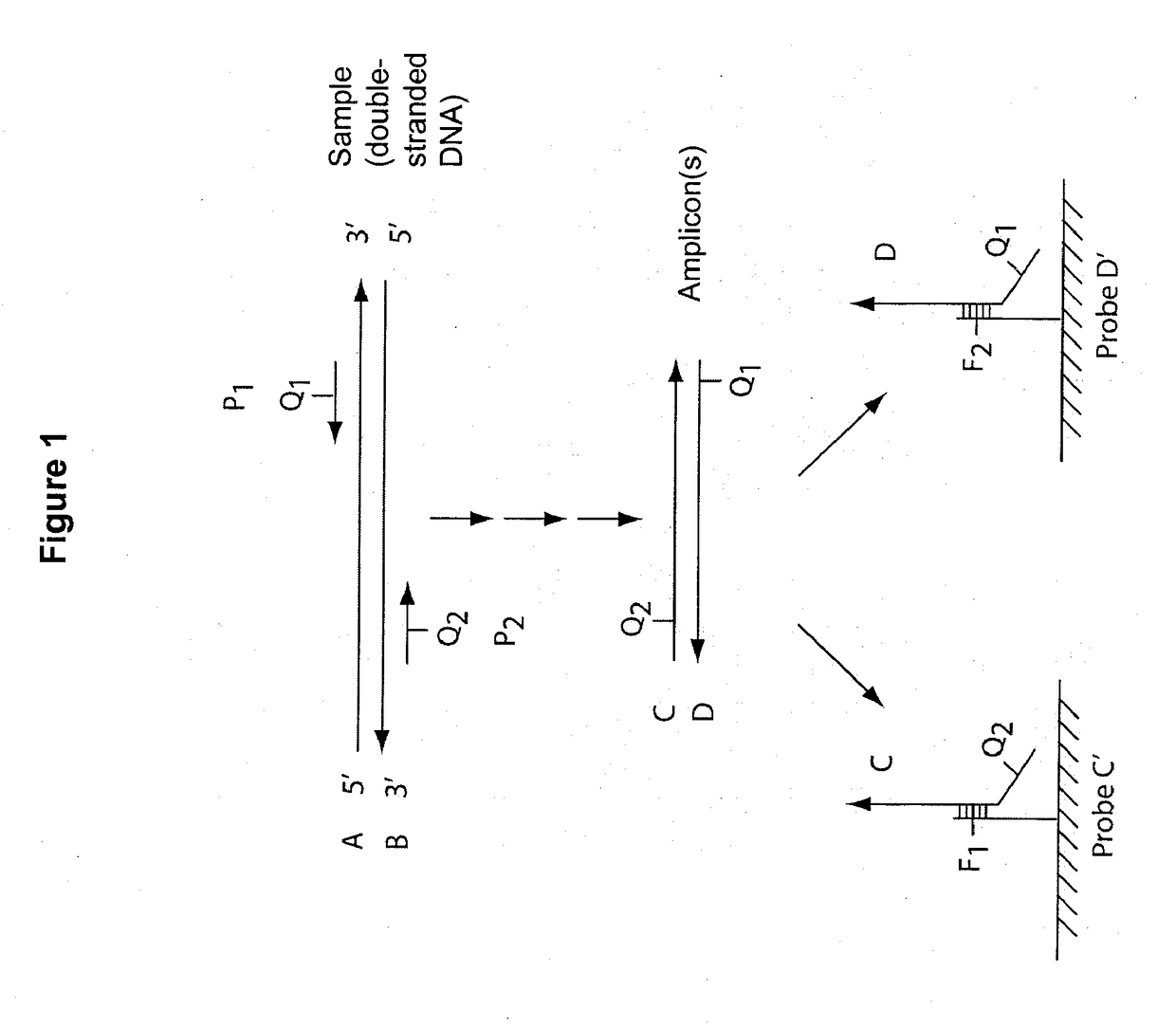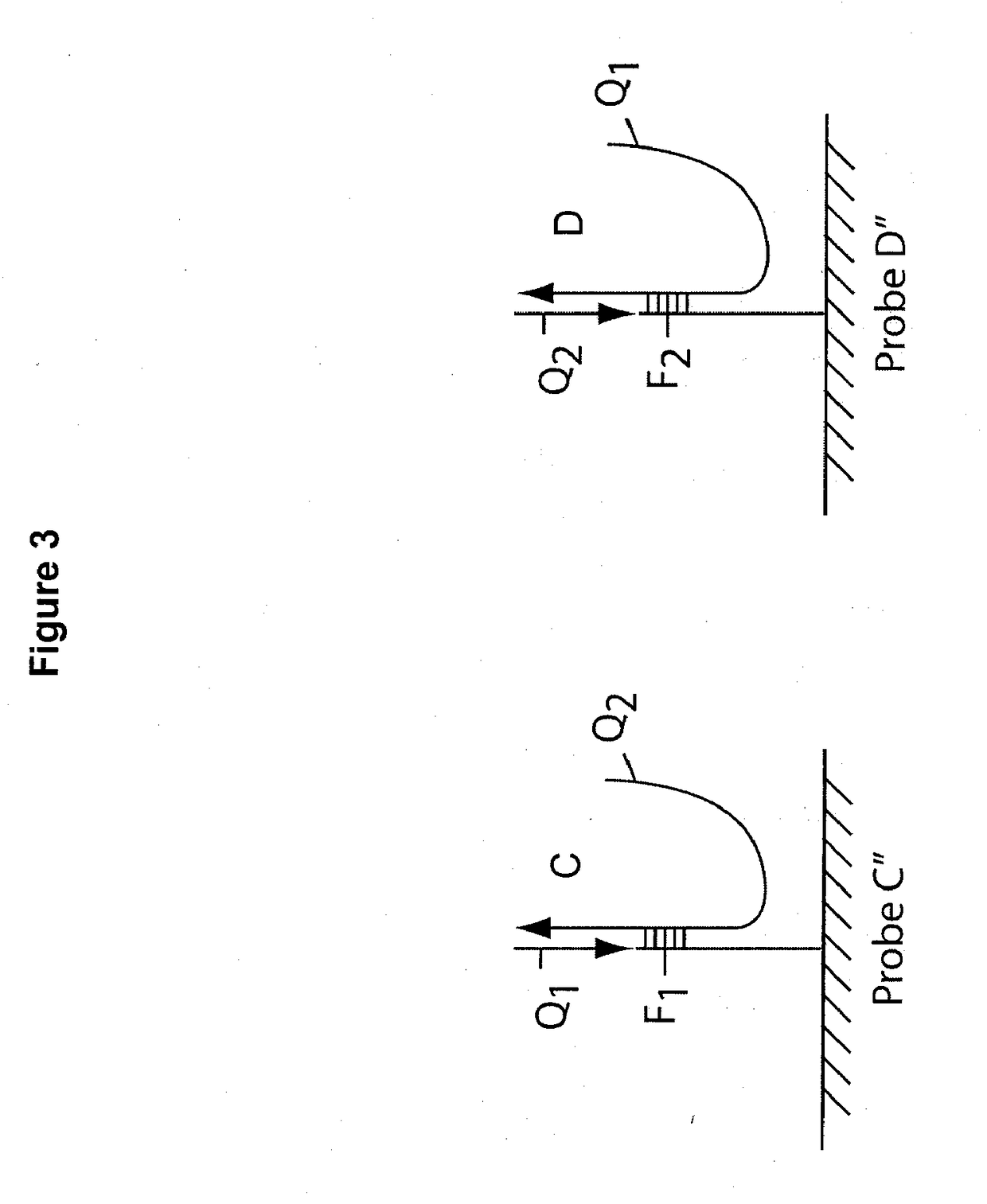Multiplex q-pcr arrays
a technology of q-pcr arrays and arrays, applied in the field of multi-dimensional q-pcr arrays, can solve the problems of adverse effects on the replication process, the limited number of different nucleic acid sequences that can be simultaneously amplified and detected, etc., and achieve the effect of reducing the amount of material
- Summary
- Abstract
- Description
- Claims
- Application Information
AI Technical Summary
Benefits of technology
Problems solved by technology
Method used
Image
Examples
example 1
[0364]This example demonstrates the use of a real-time microarray to measure the binding of multiple analytes to multiple probes.
[0365]FIG. 15 shows the layout of a 6×6 DNA microarray. Three different DNA probes (1, 2, and Control) with three different concentrations (2 μM, 10 μM, and 20 μM) are spotted and immobilized on the surface as illustrated. The probes contain a single Cy3 fluorescent molecule at the 5′ end. The DNA targets in this experiment contain a quencher molecule. The analyte binding in this system results in quenching of fluorescent molecules in certain spots. FIG. 16 shows a few samples of the real-time measurements of the microarray experiment wherein the control targets are added to the system. As illustrated in FIG. 16, the spots are quenched due to analyte binding.
[0366]FIGS. 17-20 each show data for 4 different spots with similar oligonucleotide capturing probes. The target DNA analyte is introduced in the system at time zero and quenching (reduction of signal)...
example 2
[0368]This example provides a derivation of an algorithm, and the use of the algorithm to determine analyte concentration, such as amplicon concentration, from a real-time binding data. The derivation proceeds as follows:
[0369]Assume that the hybridization process starts at t=0, and consider discrete time intervals of the length t. Consider the change in the number of bound target molecules during the time interval (iΔt, (i+1)Δt). We can write
nb(i+1)−nb(i)=[nt−nb(i)]pb(i)Δt−nb(i)pr(i)Δt,
where nt denotes the total number of target molecules, nb(i) and nb(i+1) are the numbers of bound target molecules at t=iΔt and t=(i+1) Δt, respectively, and where pb(i) and pr(i) denote the probabilities of a target molecule binding to and releasing from a capturing probe during the ith time interval, respectively. Hence,
nb(i+1)-nb(i)Δt=[nt-nb(i)]pb(i)-nb(i)pr(i)(1)
[0370]It is reasonable to assume that the probability of the target release does not change between time intervals, i.e., pr(i)=pr, for...
example 3
[0388]This example illustrates how an optical filter layer in the form of a band-pass filter on the surface of the CMOS chip enhances optical performance of the integrated biosensor array. A challenge of designing any fluorescent-based detector is the proper optical excitation and detection of fluorescent labels. FIG. 31 illustrates the absorption and emission spectra of Cy3 molecule which is an example fluorophore of a system. The absorbed photon density for Cy3, denoted by, exposed to the incident photon flux, obeys the Beer-Lambert law. For a thin layer of diluted absorbing media with Cy3 as in microarray applications we have
A=FX[1−e−a0(λ)N]≈FXa0(λ)N (16)
where a0(λ) and N are the extinction coefficient in wavelength λ and surface concentration of Cy3 respectively. Considering QY, the fluorescence quantum yield of Cy3, we can calculate IE, the total emitted photons per surface area by
IE=QYA≈QYFXa0(λ)N (17)
[0389]As evident in FIG. 31, the photon emission is, to first order, propo...
PUM
| Property | Measurement | Unit |
|---|---|---|
| temperature | aaaaa | aaaaa |
| roughness | aaaaa | aaaaa |
| roughness | aaaaa | aaaaa |
Abstract
Description
Claims
Application Information
 Login to View More
Login to View More - R&D
- Intellectual Property
- Life Sciences
- Materials
- Tech Scout
- Unparalleled Data Quality
- Higher Quality Content
- 60% Fewer Hallucinations
Browse by: Latest US Patents, China's latest patents, Technical Efficacy Thesaurus, Application Domain, Technology Topic, Popular Technical Reports.
© 2025 PatSnap. All rights reserved.Legal|Privacy policy|Modern Slavery Act Transparency Statement|Sitemap|About US| Contact US: help@patsnap.com



